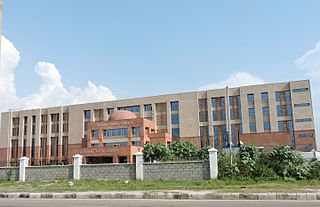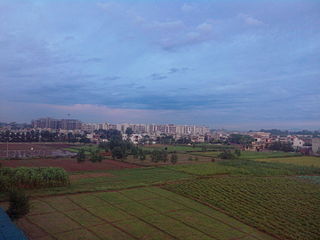
Chandigarh is a union territory and planned city in northern India, serving as the shared capital of the surrounding states, namely Punjab to the north, west and the south, and Haryana to the east. Chandigarh constitutes the bulk of the Chandigarh Capital Region or Greater Chandigarh, which also includes the adjacent satellite cities of Panchkula in Haryana and Mohali in Punjab. It is situated near the foothills of the Himalayas, 260 km north of New Delhi and 229 km southeast of Amritsar.

Mohali, officially known as Sahibzada Ajit Singh Nagar, is a planned city in the Mohali district in Punjab, India, which is an administrative and a commercial hub lying south-west of Chandigarh. It is the headquarters of the Mohali district and one of the six Municipal Corporations of the State. It is officially named after Sahibzada Ajit Singh, the eldest son of Guru Gobind Singh.

Sonipat district is one of the 22 districts of Haryana state in North India. Sonipat town is the district headquarters. It is a part of National Capital Region. It is bordered by Delhi, Panipat, Rohtak, Jind, Jhajjar and Baghpat.

Mohali district, officially known as Sahibzada Ajit Singh Nagar district or SAS Nagar district, is one of the twenty three districts of Punjab, a state in north-west India. It was formed in April 2006 and is 18th district of Punjab, created next to Pathankot district. This district was carved out of areas falling in Ropar and Patiala District. It is situated next to the union territory of Chandigarh, Ambala And Panchkula district of Haryana.
Balachaur is a town in Balachaur Tehsil in the Shaheed Bhagat Singh Nagar District of Punjab, India.
Chhachhrauli is a tehsil and Gram Panchayat town consisting of 20 wards in Yamuna Nagar district in the state of Haryana, India. It is 11 km north-east of Jagadhari. Chachhraulli is often known as "Cherapunjii of Haryana" as it receives the most rain in the whole of Haryana . It was a municipal committee until 1998. Before independence in 1947, it was the capital of the princely state of Kalsia. The origin of word Chhachhrauli is believed to be "Sat Sherawali" due to a temple located near bus terminus.
Dera Bassi is a satellite city of Chandigarh and a municipal council in Mohali district in the state of Punjab, India. Dera Bassi is located on the Chandigarh – Delhi National Highway, 8 km from Chandigarh. It is located within 20 km from Chandigarh, Mohali and Panchkula. It is strategically located near the boundary of Haryana, Punjab and Union territory of Chandigarh. Derabassi is most famous for its industrial belt, situated for the most part on Ramgarh and Barwala Road. The nearby sub town of Lalru was once a famous market for red chilli powder. The city and the nearby area host eight Engineering, B.Ed., Paramedical and Management institutes.

Zirakpur is a satellite town, in Mohali District, Punjab, neighboring Mohali, Chandigarh in India. It is set on the foothills of Shivalik hills. It is part of the tehsil Dera Bassi. It is the gateway to Chandigarh from Delhi. It comprises mainly the following areas near Chandigarh Airport including VIP Road, Dhakoli, Lohgarh, Bhabat, Bishanpura, Kishanpura, Nabha, Gazipur, Baltana, Singhpura, Peer Muchalla and Dyalpura. This town is situated on the junction of national highways Himalayan Expressway, National Highway 5 (India) towards Shimla, Ambala Chandigarh Expressway towards Ambala and National Highway 7 (India) towards Patiala.
Banga is a town and Municipal council in the Shaheed Bhagat Singh Nagar district of Punjab, India. Banga is also one of the sub-division (tehsil) headquarters of the district. Banga located on Phagwara-Rupnagar section of National Highway 344A. It is currently estimated to have a population of about 23,000 and is classified as a class 2 Municipality. The town also incorporates the former village of Jindowal apart from Banga town.
Mani Majra, also spelled as Manimajra now renamed as Sector 13, is a historical town in Chandigarh in India. It is a Puadhi Dialect area which was established by the Gharib Dass Dhillon as the capital of the newly created princely state of Dhillon clan.
Shakargarh, is a tehsil located in Narowal District, Punjab, Pakistan. Shakargarh was the only tehsil of Gurdaspur district which was included in Pakistan at the time of the independence in 1947. The literacy rate of Shakargarh is more than 97.6%, the highest in Pakistan. Pakistan Standard Time is referenced from Shakargarh.

Mata Mansa Devi is a Hindu temple dedicated to goddess Mansa Devi, a form of Shakti, in the Panchkula district of the Indian state of Haryana. The temple complex is spread of 100 acres (0.40 km2) of the Shivalik foothills in the village of Bilaspur, near Sector 13 of Chandigarh, and Panchkula, 10 km from Chandi Mandir, another noted Devi shrine in the region, both just outside Chandigarh.
Kartarpur is a village of 1.86411 sq mi (5 km2) which lies 4 km from NurPur Bedi in Tehsil Anandpur Sahib, Rupnagar district, Punjab, India and 3 km from the Kikar Lodge. Other nearby villages are Gurse Majra and Hayatpur. Kartarpur is located in the foothills of the Shivalik range of the Himalayas.

Sidhuwal is a village on the road Patiala Bhadson - approximately six kilometres from Patiala in Patiala tehsil in the Patiala district of the state of Punjab in northwest India. It is located 6 km towards North from District headquarters Patiala and 66 km from State capital Chandigarh. The village is located at the banks of Bhakra Main Line Canal. The total geographical area of the village is 644 hectares. Jasso Wal, Prem Nagar, Ranjit Nagar, Ucha Gaon, Anand Nagar are the nearby Villages to Sidhuwal. Sidhu was is surrounded by Sanour Tehsil towards the East, Nabha Tehsil towards the west, Bhuner Heri Tehsil towards the South, Ghana Tehsil towards the East. Patiala, Sirhind Fatehgarh Sahib, Gobindgarh, Nabha are the nearby Cities to Sidhuwal.
Gobindpur is a village in Shaheed Bhagat Singh Nagar district of in the Indian state of Punjab. it was originally known as Salaimpur, but later had its name changed to Gobindpur after Guru Hargobind visited it in the 17th century. It is located 3.8 kilometres (2.4 mi) away from City Banga, 19.7 kilometres (12.2 mi) from district headquarters Nawanshahr and 110 kilometres (68 mi) from state capital Chandigarh. The village is administrated by Sarpanch an elected representative of the village.
Naya Gaon(Nawa Graon or Nayagaon) is a small town and a Municipal council, formerly Nagar panchayat (Notified Area Committee) in the Majri Sub-Tehsil and Kharar Tehsil of District S.A.S. Nagar of Punjab State of India. Chandigarh borders Naya Gaon on two sides. Pin code 160103
Mansurpur is a village in Phillaur tehsil of Jalandhar District of Punjab State, India. It is located 4 km away from postal head office Bara Pind. The village is 6 km away from Goraya, 9 km from Phillaur, 39 km from Jalandhar, and 121 km from state capital Chandigarh. The village is administrated by a Sarpanch, who is the elected representative of the village. Sidhu, Dhaliwal, Mall, Jandu, Sandhu are main gotra in the village.
Jullah Majra is a village in Shaheed Bhagat Singh Nagar district of Punjab State, India. It is located 16.7 kilometres (10.4 mi) away from postal head office Garcha, 18 kilometres (11 mi) from Nawanshahr, 9.2 kilometres (5.7 mi) from district headquarter Shaheed Bhagat Singh Nagar and 99 kilometres (62 mi) from state capital Chandigarh. The village is administrated by Sarpanch an elected representative of the village.
Sountli village Situated in Tehsil Shahzadpur Tehsil in Ambala District of Haryana State, India.It is located 26 km towards East from District headquarters Ambala. 3 km from Shahzadpur. 47 km from State capital Chandigarh.








